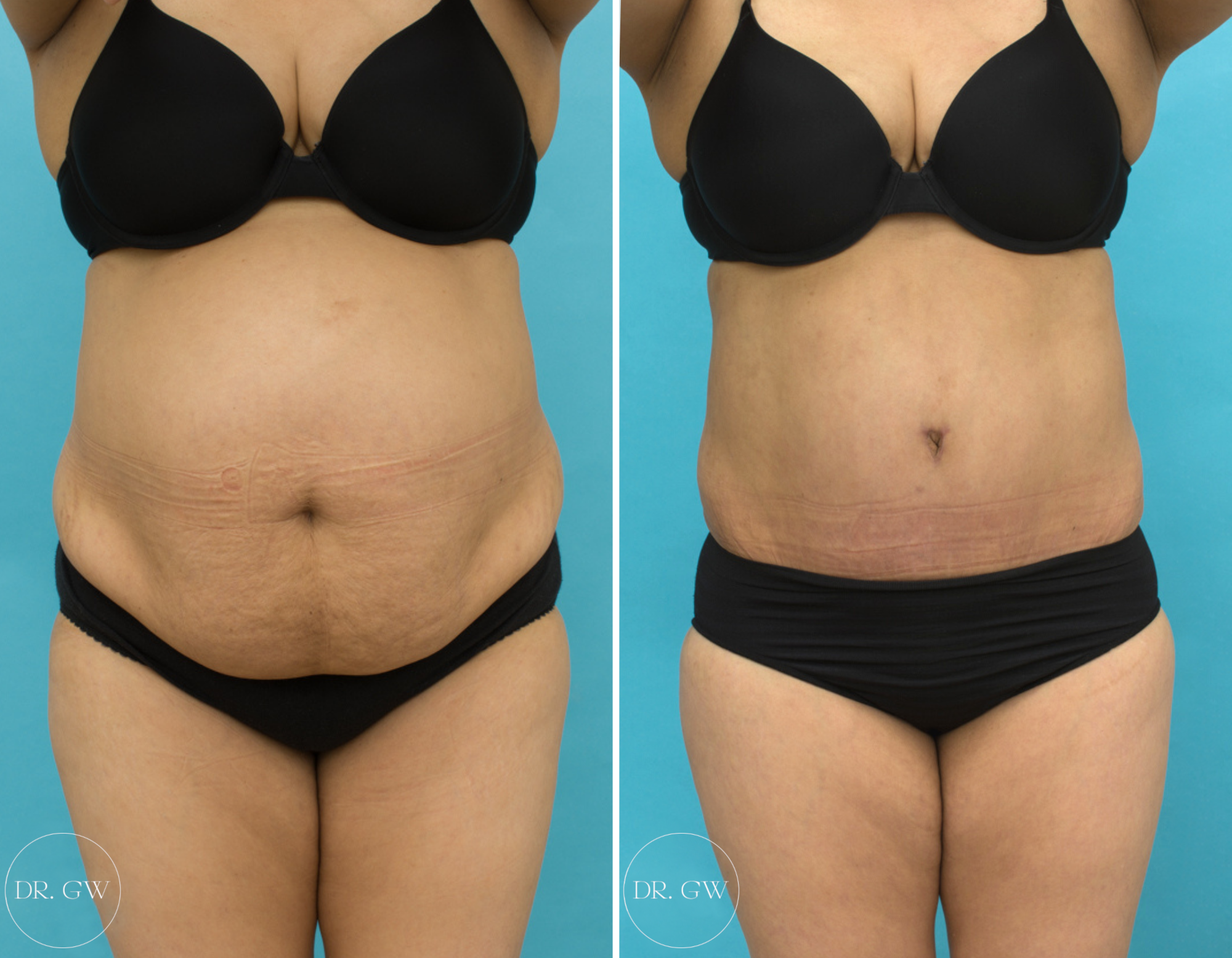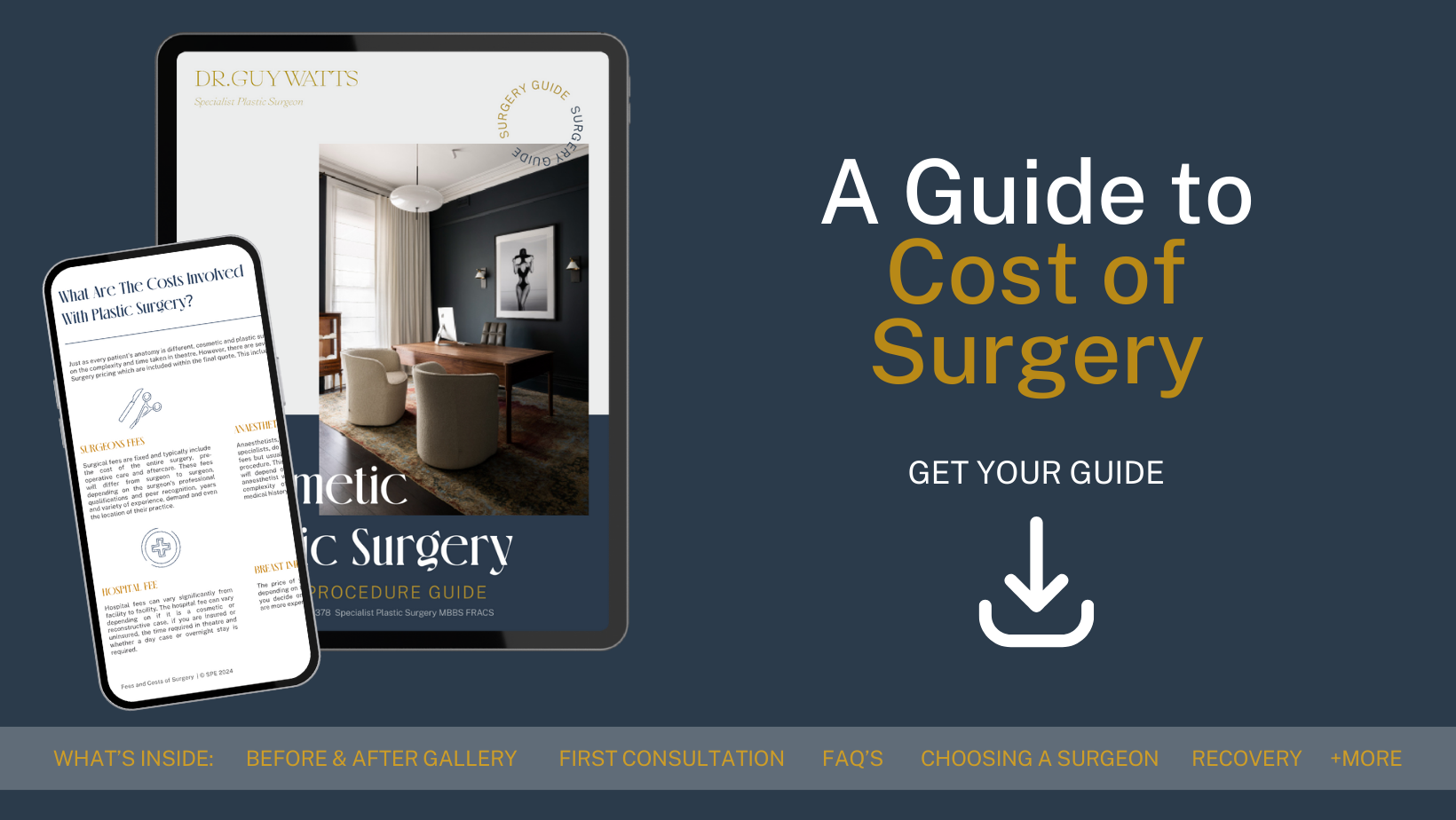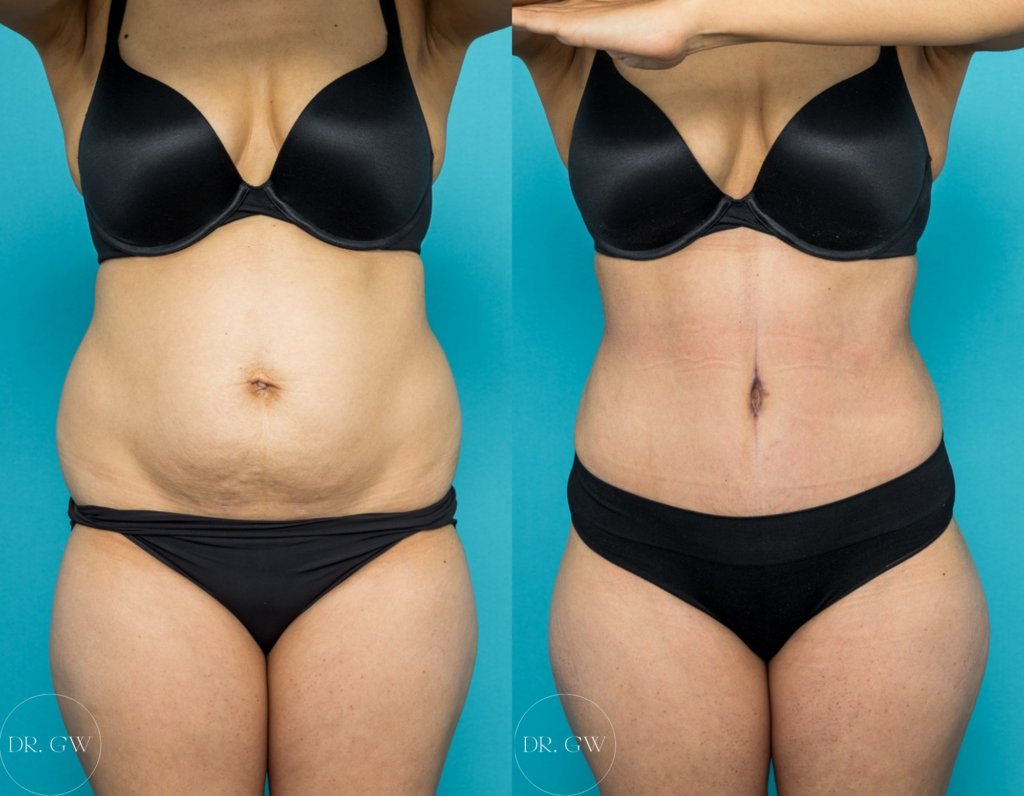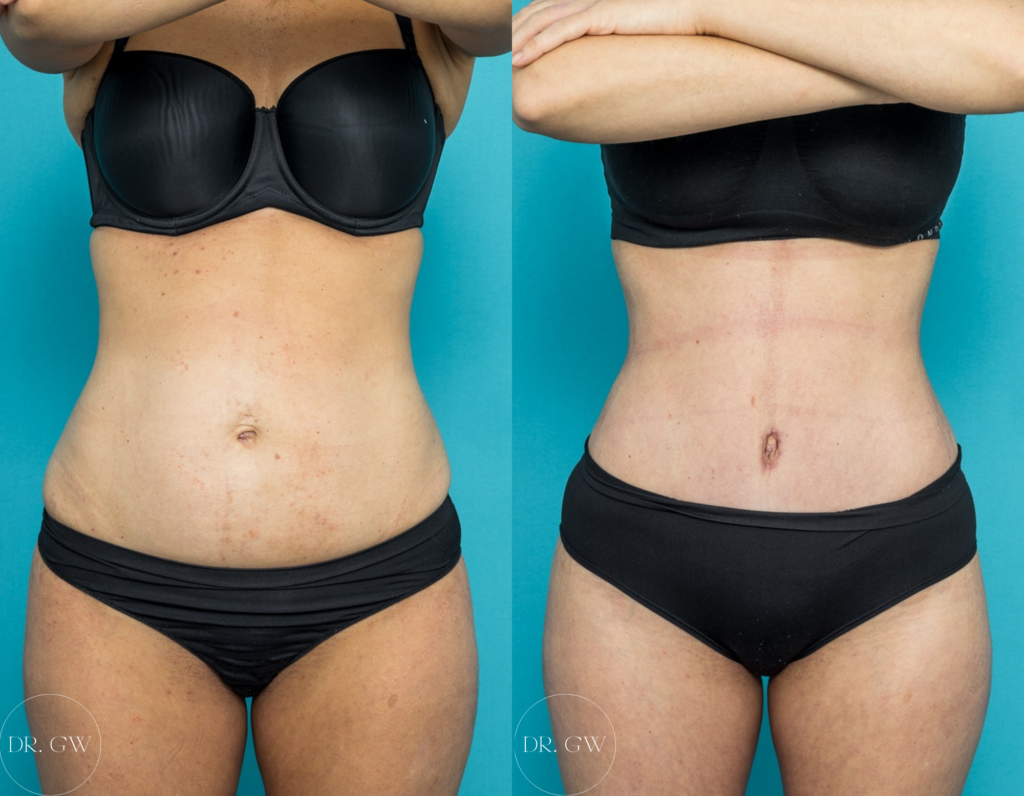
19 Oct Recovery After 360 Liposuction
360 liposuction with abdominal focus is a comprehensive body contouring procedure designed to address stubborn fat around the entire midsection – including the abdomen, flanks, and lower back. For many individuals in Perth who are exploring surgical options to address their abdominal area, understanding the recovery journey is critical.
Recovery is not simply the time following surgery; it is a structured, phased process that supports long-term outcomes and patient wellbeing. Post-operative care significantly influences how tissues settle, how swelling subsides, and how the final body contour takes shape. An informed and supported recovery journey enables patients to approach each stage with confidence, knowing what to expect and how to respond if concerns arise.
Dr Guy Watts, a Specialist Plastic & Reconstructive Surgeon based in Perth, Western Australia, provides each patient with personalised care and guidance through all stages of recovery. His focus is on clinical management, evidence-based techniques, and holistic patient education. This guide provides detailed insight into what patients in Perth can expect during recovery after 360 liposuction with abdominal focus and offers structured support for those considering the procedure.
Take our quiz, and find out if you are ready for surgery
What Is 360 Liposuction With Abdominal Focus?
360 liposuction is a circumferential fat removal technique that targets the front, sides, and back of the torso. It is often selected by individuals seeking proportional body shaping rather than isolated fat reduction in one area. The procedure involves the careful removal of excess fat deposits across the midsection, with particular emphasis on the abdomen. The outcome may include a more proportionate appearance that aligns with the body’s natural muscular structure.
In procedures performed by Dr Guy Watts at his Perth clinic, this approach is tailored to each patient’s body type, fat distribution, and skin elasticity. An abdominal focus means that the front of the midsection receives particular attention to create balance across the waistline and lower back. Through precise surgical technique, excess fat is removed to modify the shape and proportion of the torso. It is essential to understand that 360 liposuction does not address skin laxity to the same degree as procedures like abdominoplasty, and the optimal outcomes are typically seen in patients with good skin tone and elasticity.
This technique is particularly suitable for individuals who maintain a stable body weight and are in good general health. Those who have areas of fat that are resistant to diet and exercise often find 360 liposuction an effective option for achieving a more defined midsection. By addressing the entire circumference of the torso, it offers a comprehensive option to concerns around body proportion and balance. Patients are carefully assessed during the consultation process with Dr Watts, where goals, suitability, and expected outcomes are discussed in detail.
Why Recovery Deserves Careful Planning
Every surgical procedure requires recovery, but 360 liposuction demands deliberate planning to ensure that healing proceeds smoothly and predictably. The tissues involved undergo inflammation, fluid shifts, and gradual adaptation to their new contours. The quality of the recovery experience can directly affect the final outcome, influencing everything from contour definition to scar quality and overall satisfaction.
An optimised recovery plan includes not just rest, but active participation from the patient in the healing process. Following surgical instructions, maintaining healthy nutrition, and being attuned to the body’s signals are all important aspects. Understanding that the recovery timeline varies between individuals helps patients avoid frustration and fosters a more sustainable healing experience.
Patients of Dr Guy Watts receive detailed instructions and personalised check-ins to make sure they feel supported and informed. As a Specialist Plastic & Reconstructive Surgeon in Perth, Dr Watts understands the complexities of healing and the importance of a structured, phased recovery. His clinic provides ongoing education and support to guide patients through each stage of recovery, helping them recognise normal healing patterns and when to seek advice.
The First 72 Hours: Setting The Foundation
The first three days after surgery are critical. This is when the body initiates the inflammatory response, which begins the healing process. Managing discomfort, protecting the surgical site, and encouraging circulation are the top priorities. This early stage of recovery can be emotionally and physically demanding, particularly as patients may feel fatigue and experience discomfort related to swelling or tightness in the treated areas.
Compression garments are a central component of post-operative care from the outset. They help manage swelling, reduce fluid accumulation, and provide support to healing tissues. Pain relief medications prescribed by Dr Watts are to be taken as directed to keep discomfort manageable and ensure patients can move gently, which aids circulation and lowers the risk of complications such as blood clots.
It is also common for patients to experience changes in energy levels during this time. Most individuals will need to rest for much of the day, interspersed with short periods of light walking. Proper sleep positioning, typically with the upper body slightly elevated, helps reduce pressure on the abdomen and promotes more comfortable rest. Assistance at home is highly beneficial during this initial period, especially with preparing meals, maintaining hygiene, and ensuring medication schedules are followed correctly.
Dr Watts’ team in Perth ensures patients have all necessary information before they leave the clinic and are available for any early questions. Clear communication and early intervention when concerns arise contribute to a safer and more predictable recovery experience.
DOWNLOAD DR WATTS’ GUIDE TO COST OF SURGERY

Week One: Rest, Reposition, Rehydrate
The first full week after surgery is characterised by moderate swelling, tenderness, and a focus on protecting the treated areas while allowing the body to heal. This is a time when patients must balance periods of rest with gentle movement to stimulate blood flow and assist with lymphatic drainage.
Compression garments remain in place throughout this period and play a pivotal role in managing swelling. They provide external support to the healing tissues, encourage skin retraction, and reduce fluid build-up. Proper hydration is also essential as the body works to eliminate anaesthetic agents and by-products of inflammation.
Patients should avoid any lifting, straining, or twisting during this time, as the abdominal area remains particularly sensitive. Emotional reassurance is important, as many patients feel uncertain when swelling masks the underlying surgical results. This phase may involve some emotional highs and lows, which are a normal part of post-surgical recovery.
Follow-up care with Dr Guy Watts during the first week allows him to assess how tissues are responding and to ensure drains, if used, are functioning properly or ready for removal. His practice in Perth provides accessible support, ensuring each patient feels reassured and guided during these foundational days.
Weeks 2–4: Navigating The Middle Phase
During the second to fourth weeks, most patients begin to feel physically stronger and more capable of resuming everyday tasks. However, it remains essential to approach recovery with caution, as deeper tissues are still undergoing healing and should not be subjected to excessive stress.
Swelling usually begins to resolve more noticeably during this period, although it can fluctuate depending on activity levels and time of day. The body continues to expel retained fluid, and some areas may feel firmer or more sensitive than others. Asymmetrical swelling or delayed resolution in certain regions is not uncommon and typically resolves with time.
Patients may return to non-strenuous work depending on the demands of their role. While daily routines can be resumed in moderation, it is essential to avoid high-impact or repetitive movements. This includes any form of abdominal exercise or resistance training, which could disrupt the healing process if introduced too soon.
Emotionally, this period is often one of transition. As patients begin to see signs of their new contour emerging, they may also grapple with impatience or a desire to speed up the process. Continued communication with Dr Watts ensures that expectations remain realistic and that concerns can be addressed as they arise.
Months 1–3: Seeing Change, Staying Consistent
Between one and three months after surgery, the majority of patients notice clearer visual changes. The waistline appears more defined, swelling reduces significantly, and the body begins to feel more comfortable and mobile. At this stage, consistency with post-operative care continues to be vital for optimal results.
As inflammation resolves, tissues soften and adapt to the new contour. Compression garments may be gradually phased out under Dr Watts’ guidance, depending on individual healing patterns. Scar management becomes more relevant during this period, and patients may be advised on strategies such as silicone applications, massage techniques, or sun protection to support healthy scar maturation.
Physical activity can be slowly reintroduced under clinical supervision. Low-impact aerobic activities like walking, cycling, or swimming (after incisions have fully healed) can support cardiovascular health and contribute to overall recovery. Strength training and targeted core exercises should only be resumed when Dr Watts advises they are appropriate.
Follow-up reviews at Dr Watts’ Perth practice are scheduled during this phase to evaluate healing progress and ensure that patients feel confident with the trajectory of their results. Ongoing guidance at this stage provides reassurance and promotes safe reintegration into regular activities.
Abdominoplasty + 360 Liposuction Before and After Photos
Photo disclaimer:
Each surgical procedure produces unique outcomes influenced by factors such as body composition, skin tone, laxity, age, and genetics. The before-and-after photographs displayed are of actual patients and are provided for informational purposes only.
What To Watch For: Normal Vs. Concerning Signs
Being able to distinguish between expected healing changes and potential complications empowers patients to respond appropriately. Awareness reduces anxiety and supports timely communication with the surgical team if needed.
During the early weeks, it is entirely normal to experience fluctuating swelling, a sense of tightness in the torso, and temporary numbness or tingling in the treated areas. Minor asymmetry or firmness is common and usually resolves over time as fluid redistributes and tissues continue to settle. Some itchiness or sensitivity around incision sites may also occur as nerves regenerate.
However, if a patient experiences a sudden increase in swelling or pain, warmth or redness at the incision sites, or any form of discharge that appears cloudy or smells unpleasant, they should contact the clinic immediately. Systemic symptoms such as fever or difficulty breathing should also be evaluated without delay. Prompt intervention is key to resolving issues before they develop into more serious complications.
Dr Watts and his Perth-based team provide patients with clear instructions on what to monitor and how to access support after hours if needed. This level of care ensures that patients feel secure and well-informed throughout their recovery.
Emotional Milestones During Recovery
Physical recovery after surgery is well documented, but emotional recovery is often more complex and individual. Patients undergo not only physical changes but also a shift in how they perceive their bodies, routines, and even their identities.
The early days can bring a sense of vulnerability, particularly when patients are dependent on others for help. As swelling and bruising dominate the mirror, some may question their decision or worry that their goals will not be met. These feelings are valid and common.
As weeks pass, and the body begins to settle into its new shape, emotional stability often returns. Many patients report an increased focus on health and wellbeing, setting new lifestyle goals or embracing habits that align with their recovery. Emotional support, either through trusted individuals, journaling, or talking to a health professional, can be valuable during this transition.
Dr Guy Watts recognises these emotional shifts and provides reassurance and guidance. His comprehensive approach at his Perth clinic supports not just the body, but also the mind, helping patients navigate each stage with clarity.
Sustaining Your Surgical Results
Long-term satisfaction with 360 liposuction outcomes relies on lifestyle habits that support health, fitness, and weight stability. While the fat removed during liposuction is permanent, the remaining fat cells can expand if significant weight is gained.
Patients are encouraged to maintain a stable weight through balanced nutrition, regular physical activity, and adequate rest. Eating whole, nutrient-rich foods not only supports healing but also reduces inflammation and supports skin quality. Hydration continues to play a role in tissue recovery and overall health.
Protecting the skin from sun exposure is especially important during the first year after surgery, as UV rays can darken healing scars and affect their final appearance. Regular follow-ups with Dr Watts in Perth means he can confirm that long-term recovery is progressing as expected and that any concerns can be addressed proactively.
Why Choose A Specialist Plastic & Reconstructive Surgeon In Perth?
The decision to undergo 360 liposuction should always be made with a fully qualified specialist. Dr Guy Watts is a highly trained Specialist Plastic & Reconstructive Surgeon, with extensive experience in aesthetic and reconstructive procedures.
Choosing a surgeon with this level of expertise ensures that patient safety, ethical practice, and evidence-based care remain at the core of the treatment journey. Dr Watts holds specialist registration with AHPRA and performs surgery in fully accredited facilities in Perth. His patients benefit from a full continuum of care, from pre-operative planning to long-term recovery support.
Dr Watts’ approach is grounded in honesty, education, and respect for the individual. He works closely with each patient to develop a treatment plan that aligns with their goals and provides realistic expectations. This foundation builds trust and sets the stage for a more positive recovery experience.
FAQs About Recovery After 360 Liposuction With Abdominal Focus
Next Steps: Your Recovery Journey Begins Before Surgery
An informed recovery begins well before the surgery itself. Planning meals, arranging support at home, understanding compression wear, and having a recovery space set up all contribute to a stream-lined healing experience. Thoughtful preparation helps patients feel more confident and reduces the mental load after surgery.
During the consultation process, Dr Guy Watts discusses recovery expectations in detail and provides practical advice on what to arrange before surgery day. Reviewing medications, adjusting physical activity, and preparing emotionally are all part of the pre-operative journey.
At his Perth clinic, Dr Watts ensures patients are prepared before surgery and equipped with the tools and knowledge to recover with confidence. This preparation phase sets the tone for a more efficient and supportive post-operative experience.
Ready To Take The Next Step?
If you’re considering 360 liposuction with an abdominal focus and want trusted, professional care, Dr Guy Watts, Specialist Plastic & Reconstructive Surgeon in Perth, provides detailed consultations tailored to your needs.
Visit our contact page to book a consultation and take the next step in your recovery journey.
Further Reading
- Read more about Dr Guy Watts’ Blog on How to Get a Smaller Waist
- Read more about Dr Guy Watts’ Blog on How Do I Get a Flat Stomach or Flatter Abdomen
- Read more about Dr Guy Watts’ Liposuction Perth Procedure Page
About Dr. Guy Watts – MED0001539378
FRACS (Plas) – Specialist Plastic Surgeon In Perth WA
Dr. Guy Watts is a Specialist Plastic Surgeon (AHPRA MED0001539378) with an extensive career that spans across renowned plastic surgery clinics worldwide. His experience has been honed through invaluable experiences at esteemed establishments such as the New York Eye and Ear Infirmary and the renowned Pitanguy Clinic in Brazil.
Having collaborated with the foremost cosmetic plastic surgeons on a global scale, Dr. Watts has chosen to return to Perth after a 17-year journey of intensive training and invaluable professional experience to bring the latest practices and technology in cosmetic plastic surgery to his patients.
Dr. Watts is a Fellow of the Royal Australasian College of Surgeons (FRACS) and a Member of the Australian Society of Plastic Surgeons (ASPS), Australasian Society of Aesthetic Plastic Surgeons (ASAPS) and the International Society of Aesthetic Plastic Surgeons (ISAPS).
Read about the potential Risks and Complications of Surgery
Read the Patient Information and Resources
About CLINISPA
Clinispa is Dr Watts’ bespoke medical clinic performing Cosmetic Aesthetic treatments. At Clinispa, we offer advanced clinical treatments in a luxurious and calming environment, tailored to support your skin’s health and appearance.
Clinispa aesthetic services are performed by Dr Guy Watts’ nursing professionals, who have a passion for and solid understanding of facial aesthetics.
All Clinispa clients are considered individually, with a personalised treatment plan consisting of advanced scientific approaches to cosmetic aesthetics. We incorporate innovative technologies in conjunction with superiorly formulated skin care.
For more information about the full range of Clinispa Aesthetic of Cosmetic Treatments visit the Clinispa website










Sorry, the comment form is closed at this time.